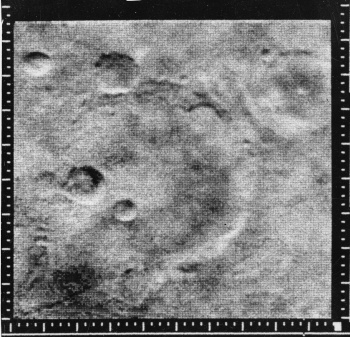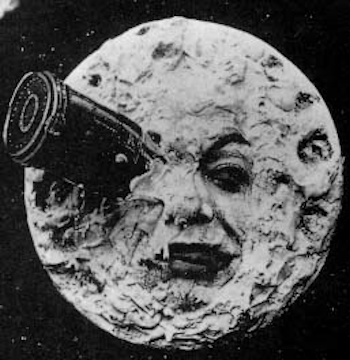Crater Counts
April 25, 2022
Our
Solar System is about 4.6 billion years old, and it was a violent place in its early
history at the
time of planet formation. The
Earth-Moon system was formed about 4.5 billion years ago when a
Mars-sized
planetoid, named
Theia,
collided with the
proto-Earth to split it into the
Earth and
Moon. Shortly thereafter, in a
geologic sense, the Earth and Moon were
pummeled by many
asteroid impacts about 3.8-4.1 billion years ago in the
Late Heavy Bombardment. Evidence of this has been erased on Earth by
environmental factors, but
cratering from this is still evident on the Moon.

An artist's conception of an impact similar to the one that resulted in the formation of the Earth-Moon system. A Mars-sized planetoid, Theia, collided with the proto-Earth about 4.5 billion years ago to create the Earth-Moon system.
I've always believed that our large and solitary Moon was a major factor in the abiogenesis of life on Earth through its tidal forces. Humanity's interest in lunar eclipses likely accelerated the development of astronomy, and science in general.
(NASA/JPL-Caltech image via Wikimedia Commons. Click for larger image.)
Although some people were still clinging to the idea of an Earth-like Mars as imagined in
Percival Lowell's 1908
book,
Mars As the Abode of Life,[1], the first close-up
images of the
surface of Mars by the
Mariner 4 spacecraft revealed a
cratered surface much like that of the Moon.

Image of Mars taken by Mariner 4, July 14, 1965.
Sending a spacecraft from one planet to another involves an initial close aiming, followed by some mid-course corrections. To do this, you need to know the orientation of your spacecraft.
For Mariner 4, this involved a star tracker that located the Sun and the star, Canopus, the second-brightest star in the night sky after Sirius.
For Mariner 4, Canopus was lost many times, a result of small dust particles that reflected sunlight and drifted through the sensor field of view.
(NASA/JPL image via Wikimedia Commons. Click for larger image.)
The
question of whether meteor impacts have presently
plateaued is the subject of
research by an international team of
planetary scientists in a recent
open access article in
Earth and Planetary Science Letters.[2-3] Team members are from
Curtin University (Perth, Australia), the
University of California - Santa Cruz (Santa Cruz, California), the
University of Toulouse (Toulouse, France), the
Université Félix Houphouët-Boigny (Cocody, Côum;te d'Ivoire), the
Planetary Science Institute (Tucson, Arizona), the
Western Australian Museum (Perth, Australia), and the
CSIRO Pawsey Supercomputing Centre (Perth, Australia). Their study has revealed that the impact flux of meteors in the inner Solar System has been constant over the last 600 million years.[2]
For lack of
evidence, planetary scientists have assumed that the impact flux of meteors has been constant over the last three billion years; that is, from about a billion years after the Late Heavy Bombardment to the present.[2] The
data, however, suggest the presence of cratering
spikes over the last two billion years caused by asteroid break-ups.[2-3] Since Mars is close to the
main asteroid belt, it's a good place to verify whether such impactor spikes have happened.[2]
The research team did their study using a
semi-automatic dating of 521 impact craters on Mars.[2] The crater detection
algorithm was developed at Curtin University, and it automatically counted the visible impact craters from a
high-resolution image.[3] They also did a
statistical assessment of the cratering rate on Earth and on the Moon and compared these results with Mars. Earth posed a problem in analysis in which the impact location of craters was adjusted by a
plate tectonic reconstruction.[2] This analysis of
terrestrial craters showed that a
cluster of craters, formed during the
Ordovician period, about 470 Ma ago and indicative of a spike, existed because of a
preservation bias.[2]

Man in the Moon from Le Voyage dans la lune (A Trip to the Moon), a 1902 silent film directed by Georges Méliès (1861–1938).
Crater face is a derogatory term for someone with very bad acne, and it was a common idiom when I was in high school in the 1960s and medicinal facial treatments were uncommon.
Wikimedia Commons image.
The
Hesperian geologic time period on Mars about 3.7 billion years ago, was one of widespread
volcanic activity that created huge
outflow channels across the surface, thereby obliterating much evidence of the Late Heavy Bombardment.[2] This left just 6,554 Martian craters for analysis.[2] Some were discarded for being
devoid of an
ejecta blanket, and the remaining craters were then
manually checked to preserve craters of 20
kilometer diameter exhibiting at least about fifty small craters superposed on its ejecta blanket.[2] The selection was limited to
latitudes between 35°N and 35°S, and this yielded the final set of 521 impact craters.[2]
The images of the 521 craters were obtained using the
THEMIS diurnal infrared mosaic images, which give good
contrast between ejecta blankets and their surrounding
terrain.[2] The main impact structure of each crater was removed by deleting a
circular area with
radius equal to 1.2 the crater radius from the
centroid of the main crater.[2] A
correlation was found between the impact flux of meteors greater than 5 meters and large asteroids (> 1 km), and this correlation does not vary over the last 600 million years.[2] The result suggests that the impact flux of asteroids greater than five meters in size was constant over the last 600 million years, and the influence of past asteroid break-ups on the cratering rate for craters larger than 100 meters is small, or non-existent.[2]

Crater counts on the ejecta blanket of a 40 kilometer impact crater. On the left, the ejecta blanket is outlined in blue, and the automatically detected craters are shown in green. Th red circles highlight impact craters larger than a kilometer in diameter. At the right, a close-up of a part of the ejecta blanket showing detected craters. (Fig. 2 of ref. 2, licensed under a Creative Commons license.[2] Click for larger image.)
As
Anthony Lagain, a research
fellow at Curtin University explains,
"On Earth, the erosion of plate tectonics erases the history of our planet. Studying planetary bodies of our Solar System that still conserve their early geological history, such as Mars, helps us to understand the evolution of our planet... The crater detection algorithm provides us with a thorough understanding of the formation of impact craters including their size and quantity, and the timing and frequency of the asteroid collisions that made them. When big bodies smash into each other, they break into pieces or debris, which is thought to have an effect on the creation of impact craters... Our study shows it is unlikely that debris resulted in any changes to the formation of impact craters on planetary surfaces."[3]
Study
co-author, leader of the team that created the crater analysis algorithm, and a
professor at Curtin University,
Gretchen Benedix, said the algorithm could also be adapted to work on other planetary surfaces, including the Moon.[3]
References:
- Percival Lowell, "Mars as the abode of life," The Macmillan Company (New York:1908), PDF file at the US Census Bureau. Page image scans are available also at the US Library of Congress. It seems strange to me that many people are still trying to monetize this 1908 book, as an Internet search will reveal.
- Anthony Lagain, Mikhail Kreslavsky, David Baratoux, Yebo Liu, Hadrien Devillepoix, Philip Bland, Gretchen K. Benedix, Luc S. Doucet and Konstantinos Servis, "Has the impact flux of small and large asteroids varied through time on Mars, the Earth and the Moon?" Earth and Planetary Science Letters, vol. 579 (February 1, 2022), Article no. 117362, https://doi.org/10.1016/j.epsl.2021.117362 This is an open access publication with a PDF file available at the same link.
- Consistent asteroid showers rock previous thinking on Mars craters, Curtin University Press Release, January 21, 2022.
Linked Keywords: Solar System; history; formation and evolution of the Solar System; time of planet formation; Earth-Moon system; Mars; minor planet; planetoid; Theia (planet); collision; collide; history of Earth; proto-Earth; Earth; Moon; deep time; pummel; pummeled; asteroid; impact event; Late Heavy Bombardment; environment (biophysical); environmental; impact crater; cratering; artist's impression; artist's conception; Mars; abiogenesis of life on Earth; tidal force; humanity; lunar eclipse; astronomy; science; NASA; JPL; Caltech; Wikimedia Commons; Percival Lowell; book; digital imaging; image; lithosphere; surface; Mariner 4; spacecraft; aiming point; command guidance; mid-course correction; orientation (geometry); star tracker; Sun; star; Canopus; second-brightest star in the night sky; Sirius; cosmic dust; dust particle; reflection (physics); reflected; sunlight; sensor; field of view; question; plateau; research; planetary science; planetary scientist; open access article; Earth and Planetary Science Letters; Curtin University (Perth, Australia); University of California - Santa Cruz (Santa Cruz, California); University of Toulouse (Toulouse, France); Université Félix Houphouët-Boigny (Cocody, Côum;te d'Ivoire); Planetary Science Institute (Tucson, Arizona); Western Australian Museum (Perth, Australia); CSIRO Pawsey Supercomputing Centre (Perth, Australia); evidence; data; transient; spike; main asteroid belt; semi-automatic; chronological dating; algorithm; image resolution; high-resolution image; statistics; statistical assessment; plate tectonics; terrestrial; cluster; Ordovician period; taphonomy; preservation bias; Man in the Moon; Le Voyage dans la lune (A Trip to the Moon); silent film; film director; Georges Méliès (1861–1938); crater face; pejorative; derogatory term; acne; idiom; Secondary education in the United States; high school; 1960s; medicine; medicinal; face; facial; preventive healthcare; treatment; Hesperian; geologic time scale; geologic time period; volcano; volcanic activity; outflow channel; devoid; ejecta blanket; manual labour; manually; kilometer; diameter; latitudes; THEMIS; diurnal; infrared; mosaic; contrast ratio; contrast; regolith; terrain; circle; circular; area; radius; centroid; correlation; Creative Commons license; Anthony Lagain; fellow; erosion; geologic record; evolution; frequency; space debris; co-author; professor; Gretchen Benedix; Percival Lowell, "Mars as the abode of life.